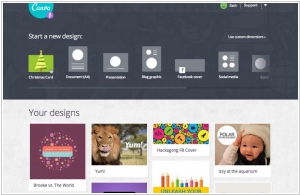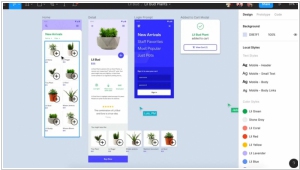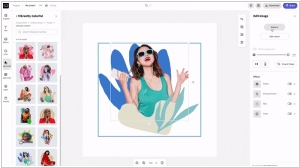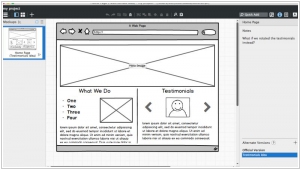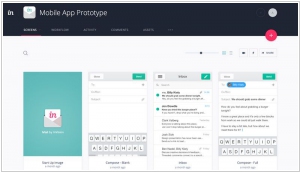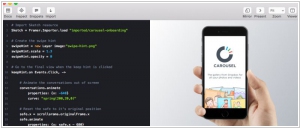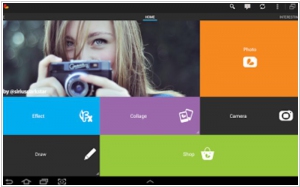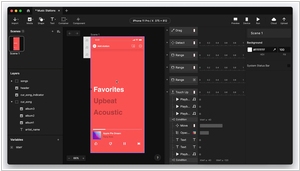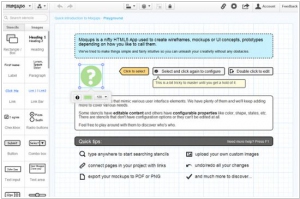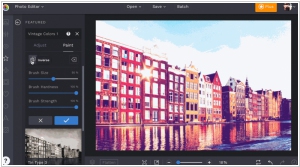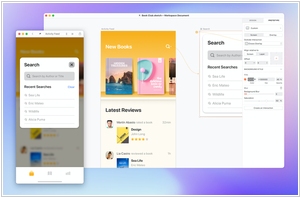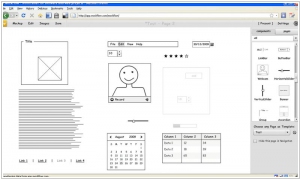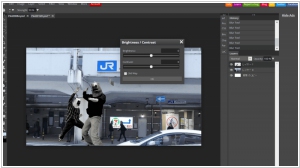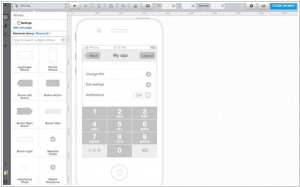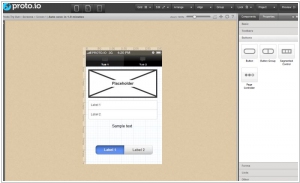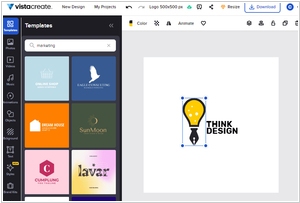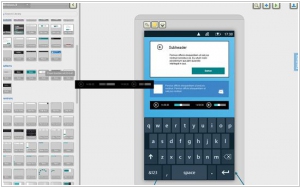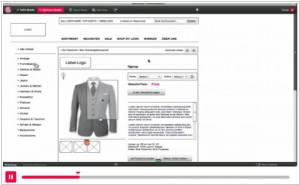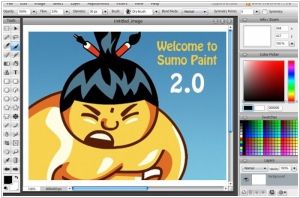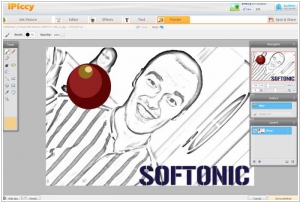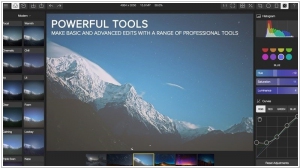Top 10 Online Design software
April 19, 2024 | Editor: Adam Levine
11
Online Design software allows to create graphical images and design prototypes in web-browser
1
Canva gives you everything you need to easily turn ideas into stunning designs. Create designs for Web or print: blog graphics, presentations, Facebook covers, flyers, posters, invitations and so much more.
2
The collaborative interface design tool. Each contributor owns their part of the creative process and stays in sync along the way - across any platform. Securely connect teams, fonts, and libraries across your entire company.
3
Creative Cloud Express (former Adobe Spark) is an online and mobile design app. Easily create stunning social graphics, short videos, and web pages that make you stand out on social and beyond.
4
Mockups really shines during the early stages of designing a new interface. Mockups offers the same speed and rough feel as sketching with pencil, with the advantage of the digital medium: drag & drop to resize and rearrange elements, make changes without starting over, and your work is clear enough that you'll make sense of them later.
5
InVision lets you transform your designs into beautiful, interactive web & mobile mockups and prototypes. Upload your designs and quickly turn them into clickable, interactive prototypes complete with gestures, transitions & animations. Send a link to open designs in a browser or on a mobile device, or present them in real-time using our LiveShare presentation tool that revolutionises the design meeting.
6
Fotor - Free Online Photo Editing & Creatives. Online photo editing & creatives made simple and fun with Fotor free online photo editor, features include photo collage, effects, online filters, frames, photo filters.
7
Framer is a new creative tool to build interaction and animation prototypes. Connect pixels to behavior and discover exciting new ways of interaction design.
8
Online photo & video editor. Find exceptional shots, creative collages, blended photos, artistic selfies, original drawings and more in our galleries.
9
The most robust browser photo editor, for all your editing needs. Online or offline. Browser-based or native app. Now for Windows and Mac as well as iOS and Android. Pixlr is ready to make moments beautiful wherever you are and whenever inspiration strikes.
10
#1 advanced prototyping tool for dynamic & multimodal interactions. Craft amazing, realistic experiences across devices
11
Moqups is a nifty HTML5 App used to create wireframes, mockups or UI concepts, prototypes depending on how you like to call them.
12
Axure RP is the only UX tool that gives UX professionals the power to build realistic, functional prototypes.
13
BeFunky online photo editor lets you apply photo effects, edit photos and create photo collages with collage maker. Online Photo editing and creating collages has never been easier.
14
Sketch is the all-in-one platform for digital design — with collaborative design tools, prototyping and developer handoff. Enables real-time collaboration.
15
PicMonkey is a free photo editor that works in your browser — nothing to download or install. Fix your photos and add beautiful filters and text. Touch up facial features or create outstanding graphics. Ridiculously easy, staggeringly gorgeous. Ads-free editing plus a kingly hoard of primo effects, supreme fonts, exclusive designs, and more
16
MockFlow WireframePro is a web-based tool to design and collaborate user interface blueprints for websites and apps. Its helps to visualize the website's interface, navigation and structure in short time. With web and desktop clients, you can design seamlessly from anywhere & even with No net-connection. Organize pages with sitemaps and define links to present a clickable prototype.
17
Photopea Online Photo Editor lets you edit photos, apply effects, filters, add text, crop or resize pictures.
18
UXPin is the UX Design Platform that gets it right. Inspired UX Design is tough with uninspired User Experience Design Tools. That's why UXPin is handcrafted to be robust & elegant.
19
Create fully-interactive high-fidelity prototypes in minutes that look and work exactly like your app should. Turn your wireframes and mobile mockups into amazing interactive prototypes. Filled with rich media, animations and touch events. Swipe, tap, rotate and examine your app inside out the same way your end user will. Share your prototype with colleagues and friends to collaborate and review.
20
VistaCreate is a free online graphic design tool with thousands of free templates for you to choose from.
21
Fluid UI helps you prototype Android, iPhone, iPad or Windows 8 mobile apps with our custom libraries, or upload your own images for pixel perfect mobile apps. Preview your mockup directly in your browser or install the Android or iOS apps to test directly on your device. Share the mockup with clients, stakeholders and users and get invaluable feedback long before writing a single line of code.
22
HotGloo lets you create and share interactive website and webapp wireframes. Wireframe in real-time with your team to get work done even faster and communicate with your co-workers via the built in chat function to avoid distraction. Good UX is all about interactions. Link elements to pages in your sitemap or set up different user scenarios with states, viewstacks and much more.
23
Sumo Paint is an online image editor, without need to install anything to your device. It's the most versatile photo editor and painting application that works in a browser. You can open and save images from your hard drive or save it to cloud.
24
iPiccy makes your photo awesome with many easy to use photo tools. Everything you need to make your photo awesome online
25
Online Photo Editing Made Fun and Easy. Ribbet lets you edit all your photos online, and love every second of it. Crop, resize, and rotate in real-time. Tons of special effects, from artsy to fun. Astoundingly fast, right in your browser
26
Polarr makes advanced free online photo editor, also available for iOS, Android, Mac and Windows with professional photo editing tools.
Latest news about Online Design software
2024. New Adobe Express mobile app allows to use AI design tools on-the-go

The freshly updated Adobe Express mobile app, now accessible on both iOS and Android platforms, introduces a revitalized experience featuring an array of new generative AI tools. Previously exclusive to the desktop version, these intuitive features, fueled by Adobe's creative generative AI, Firefly, are now conveniently available on-the-go. Adobe Express, the comprehensive AI content creation application, has become faster and more user-friendly, enabling users to effortlessly initiate posts, edit videos, craft mood boards or collages, and swiftly remove backgrounds from photos or videos. Seamlessly transition from desktop to mobile by starting a project on one and finishing, scheduling, or publishing it from the other. Real-time collaboration with team members is also facilitated, enhancing workflow efficiency from any location.
2023. Adobe and Figma end $20B acquisition plans after regulatory headwinds in Europe

Adobe's $20 billion acquisition of rival Figma has officially collapsed, as the companies cited regulatory challenges in Europe as the decisive factor leading to the abandonment of the deal. Initially revealed in September of the previous year, the significant size of the transaction and the elimination of one of Adobe's key competitors made it susceptible to regulatory scrutiny. Throughout 2023, the U.S. Department of Justice (DOJ) closely examined the deal, although no formal lawsuit had been filed to prevent its completion. In a final effort to avoid legal action, Adobe and Figma engaged in discussions with the DOJ before the weekend, ultimately resulting in the termination of the acquisition plans.
2023. Canva unveils Magic Studio, a suite of AI-powered design tools

Canva, the graphic design platform, has unveiled Magic Studio, a suite of AI-powered tools designed to simplify the creation of engaging and informative visuals. While the official launch was today, some of Canva's new features have been gradually introduced to a select group of users over the past few months. The Magic Edit trial, for example, gained attention earlier this year for its ability to modify individual elements in an image, transforming casual photos into professional headshots suitable for platforms like LinkedIn. Magic Studio represents a significant enhancement to Canva's AI offerings, introducing tools like Magic Switch, Magic Grab, Magic Expand, Magic Morph, Magic Alt Text, and Magic Animate. These tools utilize Canva's proprietary AI technology as well as contributions from partners like Google and OpenAI.
2023. Adobe launches Photoshop’s web version with Firefly-powered AI tools

Adobe has unveiled the official web version of Photoshop for users with paid plans, following nearly two years of beta testing. The web version now includes Firefly-powered AI tools like generative fill and generative expand. These tools, accessible through the toolbar, are designed around specific workflows such as image reproduction or object selection. Notably, Photoshop on the web displays the full names of the tools instead of tooltips, making it more user-friendly, particularly for beginners. Additionally, Adobe has streamlined collaboration by enabling users to share file links with others, even without a subscription, fostering easy and efficient teamwork.
2023. Startup Tezza takes on VSCO with easy-to-use photo and video editing tools

Tezza, the app for enhancing photos and videos, has set its sights on becoming the preferred tool for influencers. It offers an extensive array of resources, including hundreds of editorial templates, more than 40 handpicked presets, overlays, Instagram feed management utilities, and much more. Tezza operates in a manner quite similar to VSCO. Users simply upload their pictures or videos and then choose from a range of filters, granting their content a polished and professional appearance, all without the need to invest in the influencer-designed presets that are currently in vogue. In addition, Tezza has recently introduced "Tezza Studio," a video-editing feature that empowers content creators to easily edit comprehensive videos featuring vintage-inspired film effects, music, and a variety of presets and fonts. VSCO, on the other hand, unveiled its first video editing tool back in 2017.
2023. Adobe brings Firefly’s generative AI to Photoshop

Photoshop is receiving an infusion of generative AI through the integration of several Firefly-based features. These new additions empower users to expand images beyond their boundaries by incorporating Firefly-generated backgrounds. Additionally, generative AI can now be utilized to seamlessly insert objects into images, while a new generative fill feature enables more precise removal of objects compared to the previous content-aware fill option. Initially, these features will be exclusive to the beta version of Photoshop. Moreover, Adobe is extending some of these capabilities to Firefly beta users on the web. It's worth noting that Firefly users have already generated over 100 million images using the service.
2023. Microsoft launches its AI-powered Designer

Microsoft has launched its AI-driven design tool, Designer, in public preview mode, which comes with an expanded range of features. Similar to Canva, Designer is a web-based application that generates designs for various purposes such as presentations, posters, invitations, digital postcards, graphics, etc., which can be shared on social media or other channels. The tool uses user-generated content and DALL-E 2, an OpenAI text-to-image AI, to generate design ideas. Users can further personalize and customize their designs using drop-downs and text boxes. Designer can now even generate written captions and hashtags relevant to social media posts and provide multiple suggestions for users to choose from. Additionally, it can create animated visuals with AI-powered backgrounds and text transitions. The preview period is free and the app is accessible through the Designer website or the sidebar in Microsoft's Edge browser. Following the general release, Designer will be included in Microsoft 365 Personal and Family subscriptions with some features available for non-subscribers.
2023. Adobe Express launches an enterprise tier with generative AI tools
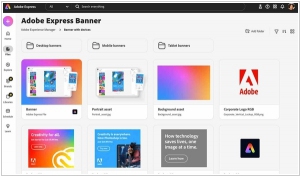
Adobe has introduced the enterprise version of its creative software, Adobe Express, which will be connected with the digital asset management platform, Adobe Experience Manager (AEM). Along with this, the enterprise package will provide access to Adobe Firefly, the company's recently introduced AI-powered creative tools. These tools allow businesses of any size to create brand content and social media posts without needing expertise in design. Adobe is essentially offering its own Canva-like software to all enterprise levels. Originally called Creative Cloud Express, Adobe launched the tool in 2021 to replace Adobe Spark and subsequently renamed it to Adobe Express.
2023. PixCap draws $2.8M to power web-based 3D design
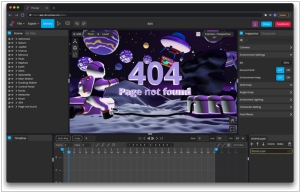
Singapore-based PixCap has recently raised $2.8 million in a seed funding round. The expenses associated with implementing 3D technology are excessively high for most startups. PixCap aims to make the transition to 3D more affordable, similar to how Canva enhanced accessibility to 2D designs. Rather than spending a significant amount of money on hiring a designer for a single campaign, marketers can swiftly create a 3D social media graphic on PixCap using its collection of templates. With just a few clicks, even individuals with no prior 3D expertise can modify the lighting and after-effects of objects, rotate them, and adjust the colors to align with their brand's palette.
2023. Kittl raises €10.8M to take on Canva
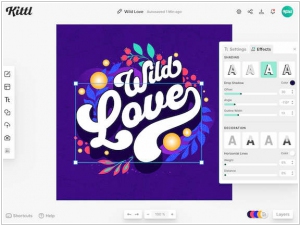
Berlin-based startup Kittl has recently secured €10.8 million in Series A funding for its design platform, which claims to empower individuals to effortlessly transform their ideas into professional graphic products. Kittl aims to eliminate the challenges associated with a steep learning curve by providing users with a fast and user-friendly design experience. The platform's features are specifically designed to simplify and streamline complex design processes, making them accessible to users with just a few clicks. Unlike its competitors, who either offer basic tools with limited creative freedom or require extensive training and practice to achieve proficiency, Kittl bridges the gap by providing an intuitive and efficient design solution. Moreover, recognizing the potential impact of AI on the industry, Kittl intends to enhance its existing AI and machine learning capabilities, capitalizing on these technologies to further advance its platform.
2022. Penpot inks $8M for its open source Figma alternative
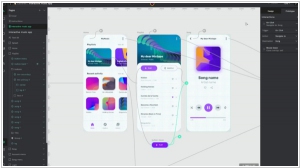
Spanish startup Penpot has secured $8 million in funding. Penpot offers a novel approach to design collaboration, utilizing an open-source platform that enables simultaneous involvement of designers and developers. The platform operates independently of specific operating systems and is web-based, utilizing open web standards like SVG. Penpot has experienced significant growth, particularly following the Adobe-Figma acquisition news. Even prior to this development, Penpot had already gained recognition in the industry. Within a year of its launch, the startup garnered tens of thousands of downloads and received 15,000 stars on GitHub. Among its active users, Penpot boasts an impressive roster of 10,000 companies, including Google, Microsoft, Red Hat, Tencent, ByteDance, and Mozilla.
2022. Adobe snaps up Figma for $20B
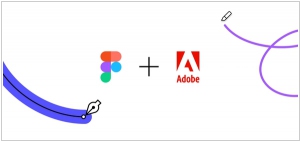
Adobe has recently announced its acquisition of Figma for a staggering $20 billion. Figma has gained popularity among individuals and teams due to its streamlined and modern cloud-based environment for design and prototyping. With approximately 4 million users to date, Figma has established itself as a prominent player in the industry. On the other hand, Adobe has been actively expanding its presence in the digital creation space through both internal developments and acquisitions. This expansion has taken Adobe beyond design and into marketing and other interconnected areas in the creation process. Design has always been at the core of Adobe's DNA, evident in their iconic products such as Photoshop, fonts, illustration, video, and 3D tools. The strategic vision behind the acquisition is to seamlessly integrate these Adobe products with Figma, positioning Figma as the native platform that unifies all of them. Adobe already had a similar offering in the form of AdobeXD, but the acquisition of Figma further strengthens its position in the design ecosystem.
2022. Canva moves beyond graphic design to launch a visual worksuite

Canva is expanding its range of offerings beyond its popular graphic design tool. The Australian company has introduced several new products to enhance its portfolio: Canva Docs, Canva Websites, Canva Whiteboards, and Data Visualization. In addition, Canva plans to expand its print services and extend its background removal technology to videos. Canva Presentations, launched in 2021, will also receive an upgrade with a remote control feature, enabling presenters to use other devices, such as a phone, as a virtual clicker.
2021. Adobe launches free online photo/video editor Creative Cloud Express
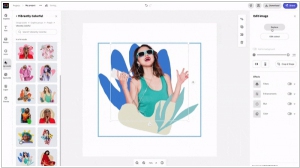
Adobe has introduced Creative Cloud Express, a new mobile and web app that combines the best features from Adobe's expansive Creative Cloud Suite and Acrobat PDF tools. This single application enables users to swiftly create various content, ranging from social media posts to promotional posters and videos. Creative Cloud Express serves as a replacement for Adobe Spark, offering a template-first approach and convenient access to stock images and other resources. The aim is to make Creative Cloud Express more accessible compared to individual Creative Cloud applications. The app will be available in both a free version and a paid subscription edition priced at $9.99 per month, featuring additional capabilities and an extensive library of complex templates. Access to this new application is included in Adobe's Creative Cloud All Apps and flagship single-app plans.
2021. Facet raises $13M for its AI-based photo editor

Content-aware image editing software Facet has recently secured $13 million in funding. The company has developed an AI-powered photo editing tool that can be accessed through APIs. With this tool, users can perform highly advanced batch photo editing, combining elements from Snapchat's photo filters, Adobe Lightroom's batch editing capabilities, Photoshop's flexibility, and the collaborative features of tools like Figma. Notably, Facet's tool introduces innovative functionalities that have yet to be seen in the field of photo editing.
2021. Vector design tool Vectornator raises $20M
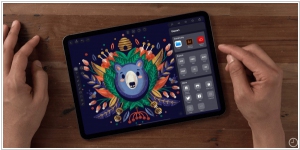
Vectornator, a platform focused on vector design, has secured $20 million in funding. Vectornator empowers users to create intricate illustrations, layout mockups, and expressive lettering at their convenience, wherever they may be. With its Auto Trace technology, the laborious task of manually tracing images is condensed into a simple button press. The text-editing tool simplifies the handling of text within your documents. You can effortlessly manipulate masks, drag and drop images, generate guides and templates, and utilize custom fonts for your print projects. Vectornator encompasses all the necessary vector tools, advanced features, and functions in an intuitive user interface, ensuring optimal performance for all your graphic design endeavors. Whether it's branding, illustrations, interfaces, websites, typography, or any imaginative concept, Vectornator serves as the ultimate creative hub.
2021. Picsart raises $130M for its visual creator tools
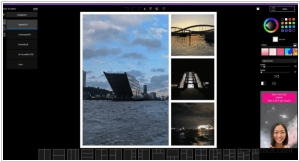
Picsart has secured a significant funding round of $130 million. The company specializes in developing mobile and desktop image and video editing tools that cater to both consumers and professionals. You've likely encountered content created using Picsart's tools across various platforms. Unlike niche APIs or specialized software, Picsart's accessible solutions make it a startup that feels more relatable to a broader audience. The company offers a combination of free and paid services, with paid products providing users with access to a wider range of images and features such as watermark removal. Additionally, Picsart provides a team-oriented plan that includes options for multi-seat purchases.
2021. Simplified raises $2.2M to bring automated content creation to marketers
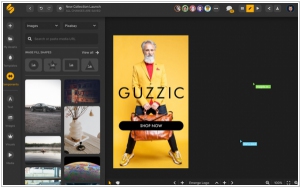
Simplified, a design software with a focus on marketing, has secured $2.2 million in seed funding as it aims to challenge Canva. Designed specifically for marketers, Simplified recognizes their significant role in generating a large volume of content across various channels. Leveraging machine learning, the platform automates much of the content creation process, including copywriting, imagery selection, formatting, and resizing, among other tasks. For instance, if a marketer intends to share an inspirational quote on social media, they can indicate the platform and search for relevant quotes, prompting the system to automatically generate suitable backgrounds. Users have the flexibility to customize elements such as typeface and image cropping before swiftly publishing their content.
2021. Figma introduces a whiteboard tool called FigJam
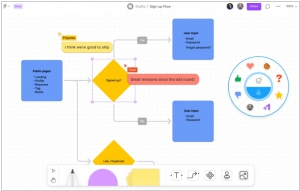
Figma, the online collaborative design service, has unveiled FigJam, a new whiteboarding tool aimed at fostering teamwork. FigJam goes beyond providing designers with a space to generate ideas collectively; it also enables nondesigners to actively participate in the brainstorming process. The tool offers a range of features, including sticky notes, emojis, drawing tools, shapes, pre-built lines and connectors, stamps, and cursor chats. Integration with Figma ensures smooth transitions as components or design objects created in FigJam can easily be transferred to Figma. Additionally, Figma is introducing voice chat functionality across all its products. This allows users collaborating on designs in Figma or engaging in brainstorming sessions in FigJam to communicate via audio without the need for separate Zoom or Google Meet calls—simply toggling on chat in Figma facilitates seamless audio communication.
2020. Skylum launches Luminar AI, its AI photo editor
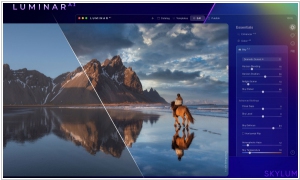
Skylum, known for its popular photo-editing apps such as Aurora HDR and Luminar, is introducing a fresh addition to its lineup with Luminar AI. Priced at $79, this brand-new photo editor is now available. Luminar AI is a standalone application for Mac and Windows users and can also function as a plug-in for Lightroom and Photos for MacOS. While it encompasses many familiar photo-editing features found in applications like Lightroom, its main emphasis lies in its innovative AI-based tools. These tools are specifically designed for enhancing landscape images, including skies, and optimizing portrait photography. Skylum has developed Luminar AI from scratch, ensuring a unique and powerful editing experience for photographers.
2020. InVision refreshes its Design System Manager
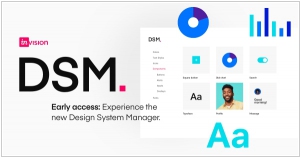
InVision, the design service, is introducing an innovative Design System Manager that provides teams with enhanced flexibility and control over the creation and maintenance of their design system. The updated features include the capability to import reusable design elements in bulk and directly upload native Sketch libraries to the InVision DSM. This empowers design system owners to effortlessly create and manage their libraries in Sketch and seamlessly transition them to InVision. Additionally, the new DSM enables one-click updates for all libraries during a company's rebranding process, eliminating the need to individually delete and replace each design asset. Instead, the entire design system can be updated simultaneously.
2020. Design platform Figma raises $50 million
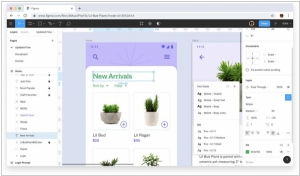
Figma, the design platform renowned for its collaborative and cloud-based approach, has recently concluded a successful Series D financing round, raising $50 million. After nearly six years of development in stealth mode, Figma was launched in 2015 with the vision of creating a collaborative design tool that functions similarly to Google Docs. Since its inception, Figma has continued to enhance its platform, focusing on expanding accessibility and usability for individual designers, small firms, and large enterprise companies. Additionally, the company introduced an educational platform called Community, empowering designers to share their work and enabling users to "remix" designs or explore them layer by layer.
2020. Ceros launches MarkUp, a design collaboration tool for live websites
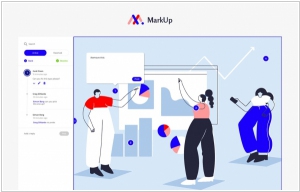
When designers need to collaborate with other teams, they often rely on tools like InVision and Zeplin. However, Ceros has identified an interesting gap in the market beyond the prototyping stage. As designers work with live or staging websites, the collaboration process becomes fragmented, involving screenshots, emails, phone calls, and Google Docs. To address this issue, Ceros is introducing a new product called MarkUp. MarkUp allows users to highlight specific areas of interest on a website, leave comments and tasks, and track revisions as they are completed. This valuable tool will operate independently from the core Ceros Studio platform and is available for free to all users.
2019. Adobe Photoshop arrives on the iPad
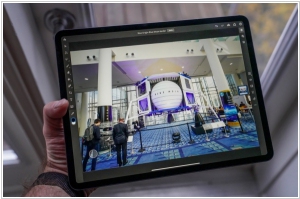
At last, Adobe has unveiled Photoshop for the iPad. It is available for a monthly fee of $9.99 as a standalone app or can be accessed through an Adobe Creative Cloud subscription. While this initial version of Photoshop for the iPad doesn't offer the same range of features as its desktop counterpart, it does support Apple Pencil for iPad Pro and newer iPad models. Additionally, it enables editing of PSD files and provides handy features like spot healing and clone stamp, making it convenient for refining edits on the go. For professionals seeking enhanced portability, combining the iPad workflow with Lightroom can be a decent solution, although it may not yet match the extensive capabilities of the desktop version. Furthermore, Creative Cloud allows you to seamlessly continue editing PSDs from where you left off across all devices.
2019. Graphic Design Software Canva launched enterprise product
Canva, the Australian design tool company, has announced a recent funding round that raised an additional $10 million, bringing its valuation to $3.2 billion. Alongside this, the company is introducing Canva for Enterprise. Up until now, Canva has provided users with a user-friendly toolkit for creating marketing and sales presentations, social media materials, and various other design products that are typically unrelated to product design. However, the challenge lies in maintaining brand consistency across the organization, especially outside the realm of product designers. While Canva remains free for individual users, the company has recognized the growing demand within professional organizations to ensure brand consistency and has responded with Canva Pro, a premium version of the product available for $12.95 per month.
2019. Graphic design platform Canva raised $70 million

Canva has secured an additional $70 million in funding to expand its graphic design platform. This funding round values the company at an impressive $2.5 billion and brings the total raised to $166 million. The announcement closely follows Canva's recent acquisitions of the free stock image providers Pexels and Pixabay, as well as the launch of a subscription service for its premium image marketplace called Photos Unlimited. However, the newly acquired capital will primarily be allocated towards the development of Canva Enterprise, a new product designed specifically for larger brands and businesses seeking enhanced brand control and collaboration capabilities. Currently, Canva boasts 15 million users across 190 countries.
2019. InVision adds new integrations with Jira
InVision has recently revealed enhanced integrations with Jira, enabling users to seamlessly embed InVision prototypes directly within a Jira ticket. Additionally, the company has introduced the Jira app for InVision Studio, granting Studio designers the ability to view interactive Jira tickets in real time. In the past, InVision had established more limited integrations with Atlassian tools such as Jira, Confluence, and Trello. This partnership is logical since Atlassian offers a complementary product to InVision, catering specifically to engineers rather than designers.
2019. InVision acquired design file versioning startup Trunk

Online design software provider InVision has completed the acquisition of Trunk, an Australia-based company exclusively dedicated to file versioning for designers. While GitHub has revolutionized version control for developers, allowing them to track changes, experiment with separate branches, and collaborate seamlessly by merging branches, designers have not been granted the same level of convenience. Typically, designers find themselves spending a significant amount of time searching through lengthy email chains in pursuit of the latest attachment version. The Trunk team will now concentrate their efforts on Studio, InVision's design tool, which was introduced approximately a year ago. With the launch of Studio, InVision showcased its ambition to transcend being a mere collaboration tool and aspire to become the design world's equivalent of Salesforce.
2019. Online design tool Figma gets new enterprise collaboration features
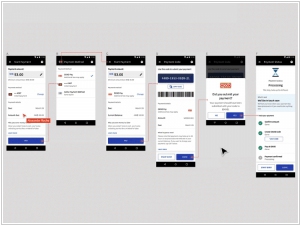
Figma, the web-based design and prototyping tool aiming to provide an alternative to similar tools like Adobe, is introducing a range of new features today to enhance collaboration across teams within large organizations. Known as Figma Organization, this feature set represents the company's first enterprise-grade service, incorporating controls and security tools that are essential for large companies. One notable addition for designers is the introduction of organization-wide design systems. While Figma already offered tools for creating design systems, this enterprise version simplifies the process of sharing libraries and fonts among teams. This ensures consistent application of styles across a company's products and services.
2018. Prototyping tool InVision is valued at $1.9 billion
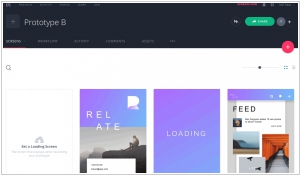
InVision, the design startup aspiring to become the Salesforce of the design industry, has officially reached unicorn status by successfully closing a $115 million Series F funding round. This latest investment brings the company's total funding to $350 million and values InVision at $1.9 billion. InVision initially emerged in 2011 as a straightforward prototyping tool, allowing designers to create interactive experiences without requiring direct involvement from the engineering team. These prototypes could then be shared with various teams, including engineering, product, marketing, and executives, for collaboration and approval. Over the years, InVision has expanded its scope to cover the entire design process, offering a comprehensive collaboration suite called InVision Cloud, enabling the involvement of every team member in the design process. Additionally, they introduced Studio, a design platform aimed at competing with industry giants like Adobe and Sketch. InVision also developed the InVision Design System Manager, a centralized solution for design teams to manage their assets and implement best practices effectively from a single location.

